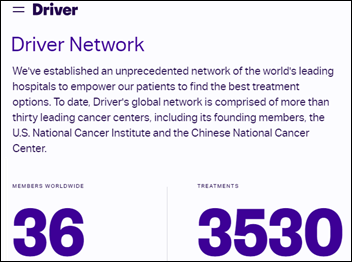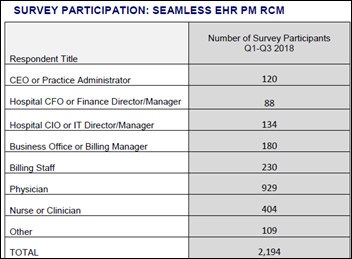Top News

Driver, whose technology matches cancer patients with clinical trials, runs out of cash and shuts down just two months after its high-profile launch.
The company had 85 employees and 30 cancer centers participating, but its revenue model was to charge patients $3,000 upfront plus a monthly fee to be matched with studies (lesson learned – never base your revenue projections on what healthcare consumers are willing or able to pay unless your product involves recreational drugs, vanity surgery, or sex).
The company says it will try to help its few paying customers transition smoothly, but cautions that it doesn’t have the money to issue refunds.
Reader Comments

From Randy: “Re: the $20 million donation to Seattle Children’s from former Microsoft CEO Steve Ballmer. I generally agree with the sentiment about big donations to hospitals instead of public health, but the Ballmer gift is to the Odessa Brown Children’s Clinic, which serves the historically underserved, African-American neighborhood in Seattle. They will use it to locate a second facility near the light rail station so that the families of patients who are displaced by Seattle housing prices can still access the clinic’s services.” I saw that and it’s indeed a good cause, although Seattle Children’s makes enough profit that they should have been able to do the right thing without waiting for Ballmer’s donation. Still, I recognize that hospitals – including whose that have employed me – never seemed to be able to get anything done without borrowing more money (probably because they were always erecting or buying new buildings), so perhaps the donation avoided that.
From BH: “Re: breach. [vendor name omitted] contacted one of our partner hospitals to inform them that an employee of the company had their credentials compromised, and that those compromised credentials may have accessed their servers. Not sure yet what products or product lines were affected, but the company that received this notice is a hospital that uses multiple products. I have not yet seen any public statement about this activity or any breach notifications” Unverified, so I’ve left the company name off for now. Forward the email to me, please.
HIStalk Announcements and Requests

Thoughts on the acquisition of Athenahealth by Veritas Capital:
- We’ve now seen health IT’s own example of the damage that can be wrought by a vulture fund that will do anything to make money by running roughshod over whatever company is unfortunate enough to find itself in its crosshairs.
- The activist investor and minority shareholder, Elliott Management, is a bone-picker, not a long-term investor (this is the company that bought heavily discounted Argentina sovereign debt, then seized one of its navy ships for non-payment). They will pressure the new Athenahealth to cut costs, sell parts piecemeal, and then run another IPO with a new story. That will likely not resonate with Veritas, which has a more measured approach (and healthcare experience) in increasing value by improving operations and strategy. It will be interesting to see how those two owners co-exist.
- We’ve also seen yet another downside of going public, where you can’t control who buys your shares or what public demands significant shareholders will make.
- Perhaps the most ironic pairing since Jimi Hendrix opened concerts for the Monkees is combining Athenahealth with the health IT assets of the former GE Healthcare. Integrating those portfolios with the Cotiviti payments processing and analytics business to create something worth more than the sum of their parts will be challenging, especially in establishing a brand identity (quick – what does Emdeon sell?)
- Athenahealth Chairman Jeff Immelt obviously brought little to the table in his short tenure as a quick Jonathan Bush replacement, spending his days trying to convince potential buyers and likely engineering the pairing of Athenahealth with the assets of GE Healthcare (after being fired by the wildly underperforming GE and previously overseeing the hot mess that was GE Healthcare IT in his executive tour that also included plastics and appliances).
- It’s likely that the acquisition marks the end of the nascent Athenahealth inpatient EHR business and thus its hopes to become an enterprise player that can compete with Epic, Cerner, and Meditech.
- Athenahealth struggled with contracting ambulatory EHR demand and some of its competitors have been acquired for presumably unimpressive sums, highlighting big problems with the ambulatory EHR/PM market in the absence of Meaningful Use stimulus and the strong trend toward health systems acquiring practices and replacing their EHR/PM systems with the hospital standard.
- GE Healthcare’s 2014 workforce management technology acquisition API Healthcare will see new life as a separate company once again. Veritas Capital acquired the well-regarded business in July 2018.
- Athenahealth’s claims of being a healthcare disruptor — which earned airplay mostly because of its charismatic and investor-entrancing former CEO Jonathan Bush — weren’t always believable since the company had a lot of India-based workers pushing paper and was an easily swatted fly of Bush’s favorite target Epic, but whatever innovation the company has accomplished or promised is probably not going to happen under private equity ownership and a CEO with no healthcare experience.
- Jonathan Bush made Athenahealth more interesting than the company deserved.

HIMSS19 starts in 90 days, so I threw down a few thoughts.
Webinars
None scheduled soon. Previous webinars are on our YouTube channel. Contact Lorre for information.
Acquisitions, Funding, Business, and Stock

Smart scheduling and throughput technology vendor LeanTaaS raises $15 million in a Series C funding round, increasing its total to $39 million.

Several health IT startup CEOs form HealthTech4Medicaid, which will advocate for Medicaid’s use of technology (with special emphasis on the ones its members sell). I’ve heard of only a handful of the 40+ companies whose CEOs are involved.
Business Insider fawns over a former exec of Facebook and Google whose company is working on continuous, wearable imaging devices that it hopes to sell in drugstores in competing with MRIs. It’s an interesting idea with a lot of potential pitfalls along the way (such as the FDA’s approval), but the real problem is that investors, startups, and consumers obsess over new diagnostic tools that can create false positives (requiring clinician time and possibly causing harm as the patient gets roped into the healthcare widget factory). We have many problems with US healthcare, but misdiagnosis and under-diagnosis aren’t anywhere near the biggest ones other than to investors looking to make mint.
The best reporter in the business, CNBC’s Chrissy Farr, reports that Alphabet will move its London-based DeepMind healthcare AI subsidiary under the newly formed Google Health, which will be led by former Geisinger CEO David Feinberg. The Google Health name is apparently being recycled from the company’s failed personal health record, which was rolled out in 2008 and shut down in 2011 when the company finally realized the obvious – nobody (including Google executives, no doubt) will bother entering their information into a PHR.
People



Veritas Capital-owned Virence Health, soon to be merged with Athenahealth under the latter’s name, hires Karl Salnoske (Laureate International Universities) as SVP of engineering and cloud operations; Sal Mahbouba (Ratava Partners) as SVP of professional services and support; and R.J. Timmons (Tenet Healthcare) as SVP and general counsel.
Announcements and Implementations
A Black Book survey of 3,000 hospital-owned or employed practices finds that 40 percent are budgeting to replace their practice management systems in favor of hospital-integrated systems, with 89 percent of hospital executives saying non-integrated EHR/PM systems impede their ability to participate in alternative payment methods. Hospitals say moving to an integrated PM system increases scheduling satisfaction, increases collections, and reduces time and resources required. Allscripts, GE Healthcare, and Cerner topped the integrated ambulatory systems review, while NextGen, Aprima, and Azalea Health took the bottom spots. The results might seem screwy, but as reader Longtime HIT Marketer reminds us, Black Book is not evaluating products or deep-diving with a handful of handpicked customers, but instead is simply reporting the perception of a statistically valid number of users. As he or she adds, “If Allscripts clients believe their products are integrated, then they are integrated.”

A Dimensional Insight survey of 85 health IT executives finds that few have high levels of trust regarding the financial, clinical, and operational data their organization makes available via self-service tools. The company recommends keeping subject matter experts involved in collecting, transforming and presenting data; automating complex data manipulation logic; and getting frontline data consumers involved.

Microsoft announces the open source FHIR Server for Azure. And please, enough with the witless “fire” puns since it’s a convenient but illogical way to sound it out (the accurate way will elicit more gasps than giggles).
Other
Analysis finds that half of the $52 billion in quarterly profits of publicly traded healthcare corporations came from just 10 companies, nine of which sell drugs. Drug companies pocketed nearly two-thirds of the profit on just 23 percent of the revenue. The new tax law that reduced corporate tax rates helped, as AbbVie paid just $14 million (0.5 percent) of its $2.76 billion in profit in taxes, while Pfizer’s tax rate was just 1.6 percent.

St. Charles Health System (OR) removes patient gender from wristbands at the urging of psychologists who say it causes harm to transgender patients while providing no benefits. Epic reviewed how it stores gender or name to determine how the information is used – to address the patient, to communicate with insurers, or for clinical purposes – although it says only one-third of customers use its expanded gender identity categories. It’s a fine line to walk when such patient characteristics as age, race, ethnicity, weight, religion, and genomic characteristics are required to make good clinical decisions, yet aren’t appropriate to use elsewhere, with the saving grace being that electronic systems can show the information only to those who need it.

I get the newsletter of innovation and investment advisor CB Insights, which also produces conferences. CEO Anand Sanwal offers these ideas that are pretty much the opposite of health IT conferences:
- No sponsors on stage, ever – it’s disrespectful to attendees to have speakers who “do a sales pitch, often dressed up as mediocre thought leadership.”
- All sessions are moderated by impartial, real journalists.
- No panel discussions since 99 percent of them are terrible
- “Thought leaders” ruin events – 47 percent of poll respondents say someone loses all credibility if they refer to themselves as a thought leader.
- Sanwal says that only four of the 100 conferences at which he has spoken in the past four years were content-first and thus good for business, while the rest had negative value. He has learned that writing content has better ROI since the audience is larger and the shelf life is longer.

The CB Insights rant led me to create my own poll. Which terms turn you off in a LinkedIn profile, Twitter profile, or speaker bio? (note: the self-flattering choices all came from the LinkedIn profiles of health IT folks whose list of accomplishments and tenure per employer are, to be kind, a bit short). I’m the only LinkedIn profile self-reporting as “blowhard” of the many who repeatedly earn the title. Has ‘health IT’s poet laureate” been claimed?

Weird News Andy pivots from his entertainingly odd stories to laud the nurses of Adventist Health Feather River Hospital (CA), who hastily evacuated patients as the Camp Fire reached the hospital’s parking lot, then had to make their way back to the hospital when their own escape routes were blocked. The hospital employees set up triage in the fire-surrounded parking lot for locals who were unable to evacuate, then were ordered by firefighters to leave when the hospital roof caught fire, by which time roads were less congested because everybody had already fled for safety.
Sponsor Updates

- FDB employees volunteer at the Midwest Food Bank to support those in need.
- Bluetree will exhibit at the RCM Leaders Forum November 14-16 in Dallas.
- Collective Medical integrates its care collaboration network with California’s CURES 2.0 prescription drug monitoring program database.
- CarePort Health will exhibit at the ACMA Western Pennsylvania event November 17.
- EClinicalWorks publishers customer success stories from Gastro Health and Big Sur Health Center.
- Carevive Systems will exhibit at the 2018 Palliative and Supportive Care in Oncology Symposium November 16 in San Diego.
- Impact Advisors is named to Consulting Magazine’s “Fastest Growing Firms” for the second straight year.
- Diameter Health will exhibit at the NCQA HL7 Digital Quality Summit November 14-16 in Washington, DC.
- A Riverside Medical Center (IL) study finds that use of Glytec’s EGlycemic Management System reduced hypoglycemia in critical care patients by 73 percent and was associated with patients transferring out 0.25 days faster.
- Meditech integrates DrFirst’s MyBenefitCheck prescription pricing solution with its Expanse EHR.
- Mental and behavioral screening technology vendor AssessURhealth is named Tampa Bay Tech’s “Emerging Technology Company of the Year” for 2018.
Blog Posts

Contacts
Mr. H, Lorre, Jenn, Dr. Jayne.
Get HIStalk updates. Send news or rumors.
Contact us.































































































Re: Dr Z. Great story, but whatever happened to professional courtesy???